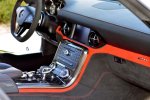- Sep 1, 2005
- 704
PART 1
Special dispatch to my brethren of the Fordgtforum.
About a year ago, I bought a Mercedes SLS. I was impressed with that car, and through an interesting stroke of happenstance, my local dealer offered me the state’s one and only allocation of an SLS Black Series. The catch was that I would have to wait the better part of a year for it to arrive. I snapped up the opportunity, chose the specification (it had to be silver, as any good German car should be) and commenced waiting. Having been through this drill with my previous Ferrari orders, it was both familiar and frustrating.
The car arrived just before Christmas, and it sat in my garage sheltered from the inclement winter weather and salty roads for the better part of a month. I finally ran out of patience, loaded the car in my trailer, and winged south to the warmth of the desert. I’ve been enjoying it here in the toasty southwest ever since, while some of you have been basking in the polar vortex.
In my previous reviews, I’ve gone through a brief introduction of both the newcomer and the GT. In this case, I’m going to skip a lengthy description of the GT, since I am quite confident that this audience requires no such exercise.

THE SLS BLACK SERIES
The SLS is a two passenger, front engine, rear drive car and is the first vehicle designed and built entirely by AMG. It is powered by a normally aspirated , overhead cam V8, displacing about 379 cubic inches. The Black Series is a super limited production version of the car, featuring wider body panels, fatter tires, more horsepower (622 vs. 583) and various carbon and titanium parts to reduce weight by about 150 pounds under the standard car. It also has massive carbon brakes.
Having owned and driven both the standard SLS and the Black Series, I am at pains to emphasize the enormous difference between the two cars. This has become the most surprising and pleasing aspects of the Black for me. By far, the most significant improvement is the glorous reprogramming they’ve done to the transmission.
The SLS uses a dual clutch manu-matic built by Getrag. In the standard car, the shift action was a bit of disappointment. Not terrible, maybe on par with discovering on the honeymoon that your spouse was not the gender you had anticipated. My primary gripe was not that the car shifted slowly, which it did not. The physical change of gears is blink quick, and in auto mode, it is world class. The problem was that when switched to manual, the delay between the input of paddle and the response of the transmission was lethargic. It seemed to me that the delay was the equivalent of a normal slush box driven with paddles, like my S550. Since I always drive my manumatics in manual mode as a matter of principle, this was a big let down. Especially compared to the 458 I had owned.
The tranny in the Black has been transformed. It cracks off shifts with same thrilling urgency of the 458, but coupled with the torque of the monster V8, the effect brings a smile to the face of even the most ardent 3-peddle fan. There is no denying that a properly tuned DCT is simply a faster, more efficient way to change gears than a true manual. If you doubt this, look at virtually every race car built in last five years. (Be that as it may, I still prefer a true manual for street use).

Other differences in the Black are just what you would expect. Super quick steering, super responsive throttle in relation to throttle travel. The gear ratios of the Black are tighter, resulting in more fierce acceleration in all gears. And my gracious, the noise, men, the NOISE! The Black features an ultra light titanium exhaust system which sounds like a communion between Nascar and Mozart. I’ve never heard anything like it, and when you are slapping gears at redline, the effect is the equivalent of a conjugal visit with the mechanical mistress known as Ms. Rumblestein. I revved it next to a Corvette the other day at a red light, and I swear I could hear that poor car draining its crankcase onto the pavement right there in public. Of course the grand irony is that it’s a highfalutin European car that is making all those distinctly American noises. Trust those German engineers to take it to a whole nuva leval.
COMPARISONS
Engine
This part makes for a fascinating comparison, since both cars use a similar power plant; V-8, 32 valves, overhead cams, dry sump, all the proper features of a true high tech torque master. Not a push rod to be found. The significant difference is that the GT is supercharged, while the Black is not. If you were to therefore presume that the throttle response of the Black would be more crisp, and you would be right. In stock form, the Black allegedly makes nearly 70 more horsepower than the GT without the inherent compromises of the supercharger. The result is that the Black has that razor sharp, immediate response from any rpm. The Black also enjoys the benefits of 8 years of advancements in engine management technology that make the comparison a bit unfair. I should also add that the Black has much shorter gearing than the GT and a hair trigger throttle, both of which can be deceiving when comparing engine responsiveness. But, you can’t argue with physics, and an unboosted engine is just going to feel more urgent than its blown or turboed equivalent.
The GT engine is no slouch, however, and driven in isolation it remains one of my favorite engines of all time. It surpasses the Black in stock torque, and is oh so easy to modify. However, on cold, lonely nights, I like to imagine what the GT would feel like with the Black V-8 bolted between its frame rails. I would miss those blue cam covers, however….
Styling
The Black has a humongous hood. You could probably land a Piper Cub on in and still have to taxi for awhile to fall off. On the Black, they have molded two long runners into the length carbon fiber hood, and added a negative pressure inlet in exposed fiber that really makes it more attractive, but it is still a huge surface. A couple of bystanders have asked whether it has a v-12 in it, based on the size of its front end. Not only does it NOT have a V-12, the V8 it does have is tucked tight against (and under) the firewall, leaving lots and lots of space in the engine compartment. Viewed from the front and back, the Black appears quite wide and flat, a surprise for a European car. Suffice it to say that the SLS will not be touring the ancient cobblestone “roads” of the traditional medieval European walled cities. This is an autobahn car, if ever there was one.

After giving all the emphasis to the hood, the cab looks tiny, and the back end just sort of falls off. On the Black, they have added a honkin’ rear wing. While it may be anything but subtle, I like it and think it adds a satisfying gravitas and balance to the backside of the car. The wider body panels and fat rubber make the car look significantly more menacing than the standard car; if the SLS is an Imperial Stormtrooper, then the Black is Darth Vader. Viewed from the side, the Black is all about horizontal lines, long hood, long rockers, long doors. Its cool looking and the carbon wings and spoilers give it a swagger than is completely absent in the standard car. In some ways, it’s a Marvel Comic version of the original SLS.

The GT, by comparison, makes the Black look boxy and almost conventional. For all the visual interest the Black generates, put it next to the GT and it’s like comparing a hopped-up Cessna with a Gulfstream. The GT just telegraphs its mission more convincingly. Interestingly, both cars are based upon historic themes, the Black on the Gullwing from the 50s (a touring car) and the GT on the Mulsanne dominating race cars of Le Mans. Predictably, the Black is an obvious attempt to make an existing design (the SLS) more racy, while the GT was and has, always been a race car at heart. This is one of the things that I think makes the Ford GT so darn special and desirable.

[
Special dispatch to my brethren of the Fordgtforum.
About a year ago, I bought a Mercedes SLS. I was impressed with that car, and through an interesting stroke of happenstance, my local dealer offered me the state’s one and only allocation of an SLS Black Series. The catch was that I would have to wait the better part of a year for it to arrive. I snapped up the opportunity, chose the specification (it had to be silver, as any good German car should be) and commenced waiting. Having been through this drill with my previous Ferrari orders, it was both familiar and frustrating.
The car arrived just before Christmas, and it sat in my garage sheltered from the inclement winter weather and salty roads for the better part of a month. I finally ran out of patience, loaded the car in my trailer, and winged south to the warmth of the desert. I’ve been enjoying it here in the toasty southwest ever since, while some of you have been basking in the polar vortex.
In my previous reviews, I’ve gone through a brief introduction of both the newcomer and the GT. In this case, I’m going to skip a lengthy description of the GT, since I am quite confident that this audience requires no such exercise.

THE SLS BLACK SERIES
The SLS is a two passenger, front engine, rear drive car and is the first vehicle designed and built entirely by AMG. It is powered by a normally aspirated , overhead cam V8, displacing about 379 cubic inches. The Black Series is a super limited production version of the car, featuring wider body panels, fatter tires, more horsepower (622 vs. 583) and various carbon and titanium parts to reduce weight by about 150 pounds under the standard car. It also has massive carbon brakes.
Having owned and driven both the standard SLS and the Black Series, I am at pains to emphasize the enormous difference between the two cars. This has become the most surprising and pleasing aspects of the Black for me. By far, the most significant improvement is the glorous reprogramming they’ve done to the transmission.
The SLS uses a dual clutch manu-matic built by Getrag. In the standard car, the shift action was a bit of disappointment. Not terrible, maybe on par with discovering on the honeymoon that your spouse was not the gender you had anticipated. My primary gripe was not that the car shifted slowly, which it did not. The physical change of gears is blink quick, and in auto mode, it is world class. The problem was that when switched to manual, the delay between the input of paddle and the response of the transmission was lethargic. It seemed to me that the delay was the equivalent of a normal slush box driven with paddles, like my S550. Since I always drive my manumatics in manual mode as a matter of principle, this was a big let down. Especially compared to the 458 I had owned.
The tranny in the Black has been transformed. It cracks off shifts with same thrilling urgency of the 458, but coupled with the torque of the monster V8, the effect brings a smile to the face of even the most ardent 3-peddle fan. There is no denying that a properly tuned DCT is simply a faster, more efficient way to change gears than a true manual. If you doubt this, look at virtually every race car built in last five years. (Be that as it may, I still prefer a true manual for street use).

Other differences in the Black are just what you would expect. Super quick steering, super responsive throttle in relation to throttle travel. The gear ratios of the Black are tighter, resulting in more fierce acceleration in all gears. And my gracious, the noise, men, the NOISE! The Black features an ultra light titanium exhaust system which sounds like a communion between Nascar and Mozart. I’ve never heard anything like it, and when you are slapping gears at redline, the effect is the equivalent of a conjugal visit with the mechanical mistress known as Ms. Rumblestein. I revved it next to a Corvette the other day at a red light, and I swear I could hear that poor car draining its crankcase onto the pavement right there in public. Of course the grand irony is that it’s a highfalutin European car that is making all those distinctly American noises. Trust those German engineers to take it to a whole nuva leval.
COMPARISONS
Engine
This part makes for a fascinating comparison, since both cars use a similar power plant; V-8, 32 valves, overhead cams, dry sump, all the proper features of a true high tech torque master. Not a push rod to be found. The significant difference is that the GT is supercharged, while the Black is not. If you were to therefore presume that the throttle response of the Black would be more crisp, and you would be right. In stock form, the Black allegedly makes nearly 70 more horsepower than the GT without the inherent compromises of the supercharger. The result is that the Black has that razor sharp, immediate response from any rpm. The Black also enjoys the benefits of 8 years of advancements in engine management technology that make the comparison a bit unfair. I should also add that the Black has much shorter gearing than the GT and a hair trigger throttle, both of which can be deceiving when comparing engine responsiveness. But, you can’t argue with physics, and an unboosted engine is just going to feel more urgent than its blown or turboed equivalent.
The GT engine is no slouch, however, and driven in isolation it remains one of my favorite engines of all time. It surpasses the Black in stock torque, and is oh so easy to modify. However, on cold, lonely nights, I like to imagine what the GT would feel like with the Black V-8 bolted between its frame rails. I would miss those blue cam covers, however….
Styling
The Black has a humongous hood. You could probably land a Piper Cub on in and still have to taxi for awhile to fall off. On the Black, they have molded two long runners into the length carbon fiber hood, and added a negative pressure inlet in exposed fiber that really makes it more attractive, but it is still a huge surface. A couple of bystanders have asked whether it has a v-12 in it, based on the size of its front end. Not only does it NOT have a V-12, the V8 it does have is tucked tight against (and under) the firewall, leaving lots and lots of space in the engine compartment. Viewed from the front and back, the Black appears quite wide and flat, a surprise for a European car. Suffice it to say that the SLS will not be touring the ancient cobblestone “roads” of the traditional medieval European walled cities. This is an autobahn car, if ever there was one.

After giving all the emphasis to the hood, the cab looks tiny, and the back end just sort of falls off. On the Black, they have added a honkin’ rear wing. While it may be anything but subtle, I like it and think it adds a satisfying gravitas and balance to the backside of the car. The wider body panels and fat rubber make the car look significantly more menacing than the standard car; if the SLS is an Imperial Stormtrooper, then the Black is Darth Vader. Viewed from the side, the Black is all about horizontal lines, long hood, long rockers, long doors. Its cool looking and the carbon wings and spoilers give it a swagger than is completely absent in the standard car. In some ways, it’s a Marvel Comic version of the original SLS.

The GT, by comparison, makes the Black look boxy and almost conventional. For all the visual interest the Black generates, put it next to the GT and it’s like comparing a hopped-up Cessna with a Gulfstream. The GT just telegraphs its mission more convincingly. Interestingly, both cars are based upon historic themes, the Black on the Gullwing from the 50s (a touring car) and the GT on the Mulsanne dominating race cars of Le Mans. Predictably, the Black is an obvious attempt to make an existing design (the SLS) more racy, while the GT was and has, always been a race car at heart. This is one of the things that I think makes the Ford GT so darn special and desirable.

[
Last edited:






